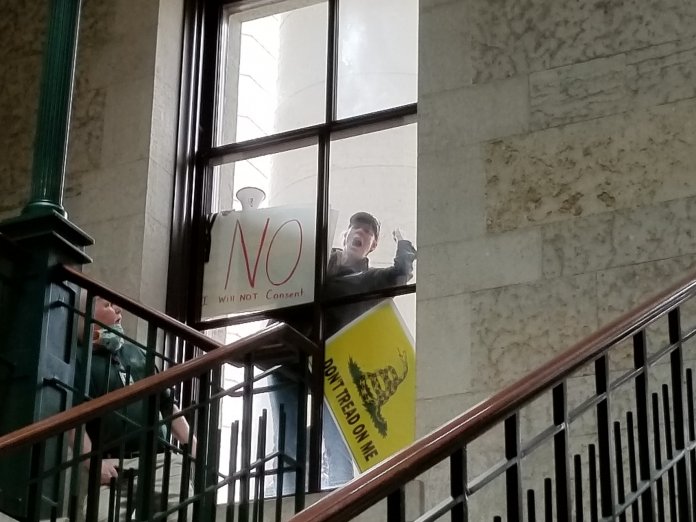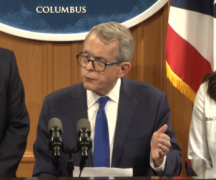Even hours before polls closed Tuesday, it was clear the virus that causes COVID-19 was in for a good night in Ohio.
COVID-19 is infecting, hospitalizing and killing record numbers of Ohioans at an accelerated clip, according to data from the Ohio Department of Health. More new infections were reported Tuesday than any day during the pandemic.
Regardless, Ohioans voted to reelect President Donald Trump, who has repeatedly downplayed the pandemic and called it a ‘hoax,” by an 8-point margin. The election nationally is still too close to call as of Wednesday evening.
Statehouse Republicans, who have repeatedly pushed legislation to strip ODH of its ability to issue public health orders, also picked up three state House seats and one state Senate seat, according to preliminary election results. They previously had a 61-38 majority in the House and 24-9 majority in the Senate.
Rep. Dave Greenspan, the only incumbent House Republican to lose Tuesday, was one of the only two House Republicans who opposed legislation that would have given lawmakers control over ODH orders.
Both the House and Senate conceivably could have the votes to override Gov. Mike DeWine, who has said he would veto any legislation that weakens health department powers during the pandemic.
Public health experts said in interviews that Ohio is careening on a dangerous trajectory as it is, and now is not the time to go cutting the brakes.
“Right now, I don’t see any indication of a peak — the peak, to me, could be double what we have today,” said Dr. Mark Cameron, an immunologist and infectious disease researcher with Case Western Reserve University.
“I think any additional loosening of government mandates or public health guidelines is only going to feed this surge, only give this virus more opportunity to spread in these communities, get to more vulnerable people in this state, and kill more people. It’s as simple as that.”
On Wednesday, the seven-day moving average of new cases per day in Ohio surpassed 3,500 for the first time. There were nearly 2,000 currently in the hospital, a new record, of the 19,800 hospitalized with COVID-19 since March. Fifty-five new deaths were reported, raising the toll to 5,428.
But on Election Day, Senate President Larry Obhof co-sponsored legislation that would overturn an ODH order limiting county fairs to junior fair activities. The legislation claims it is “necessary for the immediate preservation of the public peace, health, and safety” because it is “necessary to reopen the state.”
The legislation is presumably irrelevant until county fair season next summer, though it could be a harbinger of legislative fights to come. An Obhof spokesman did not respond to inquiries.
It takes 20 Senate votes to override a governor’s veto. Senate Bill 311, legislation that would strip ODH of much of its quarantine power, passed with 20 votes exactly. Sen. Sean O’Brien, who lost his reelection bid, voted against the bill when the Senate passed it in September. The House has not yet taken up the proposal.
The House of Representatives, meanwhile, passed legislation in May that would give the General Assembly the ability to rescind ODH orders after two weeks. The bill is stuck in conference committee after different versions were passed by the two chambers.
In July, DeWine vetoed Senate Bill 55, which would lift penalties for violating ODH orders. The bill passed with 72 House votes (enough to override a veto) and 18 Senate votes (not enough).
“In the midst of this pandemic, now is not the time to change tactics and impede local health officials’ ability to protect all Ohioans,” he said in a veto message.
A DeWine spokesman did not respond to inquiries about the potential for a veto override.
Dr. Amy Edwards, an infectious disease specialist with the University Hospitals network, said the outbreak is out of control right now in Ohio and leaders need a stricter and more cohesive approach.
She criticized lawmakers for downplaying the virus for political gain, spreading misinformation about it, sowing doubt in ODH data, and trying to roll back public health orders as the situation worsens.
“The reason people aren’t taking this seriously is because politicians aren’t taking this seriously,” she said. “For better or for worse our leaders … these are the people that we see every day on the television, and they have a role to play.”
***
Also from Ohio Capital Journal:
How will the additional ballots counted impact the Ohio Statehouse results?
The dynamic of absentee and provisional ballots being counted after Election Day has the potential to affect numerous Ohio Statehouse races.
Republicans currently hold a 61-38 lead in the Ohio House of Representatives and a 24-9 lead in the Ohio Senate.
As it stands, the GOP has flipped at least four seats in the House that are currently held by Democrats, while there is one seat that is currently poised to flip from red to blue. With some districts still too close to call, it appears the Republican Party will net at least a few House seats headed into a new term.
In the Senate, the Republicans appear to have flipped one Democrat-held seat. Another GOP-held seat is the closest election of all, and if Democrats can win it the chamber would remain with the same power breakdown as it has now.
The Ohio Secretary of State’s website offers the number of outstanding absentee ballots as well as the number of not-yet-counted provisional ballots for each county. However, there is not a specific breakdown which specifically gives how many additional ballots will be counted within each district. READ MORE
It’ll be awhile before we know the true outcome of the Ohio vote
Outstanding ballots — including some that might still be sitting in the post office — mean that it will be some time before Ohioans know how Tuesday’s election actually ended up.
Those votes could be a difference maker in some races.
As of Wednesday afternoon, almost 312,000 outstanding votes remained to be counted, according to the Ohio secretary of state’s website. Those are absentee ballots that were requested but not returned to the county board of elections by Nov. 3 or provisional ballots.
Even if they all came in for Joe Biden, they wouldn’t overcome the 400,000 votes that Donald Trump won in the Election Night count. But they could sway several Statehouse races, including a state Senate race in which the Republican incumbent leads her Democratic challenger by just 42 votes. READ MORE





